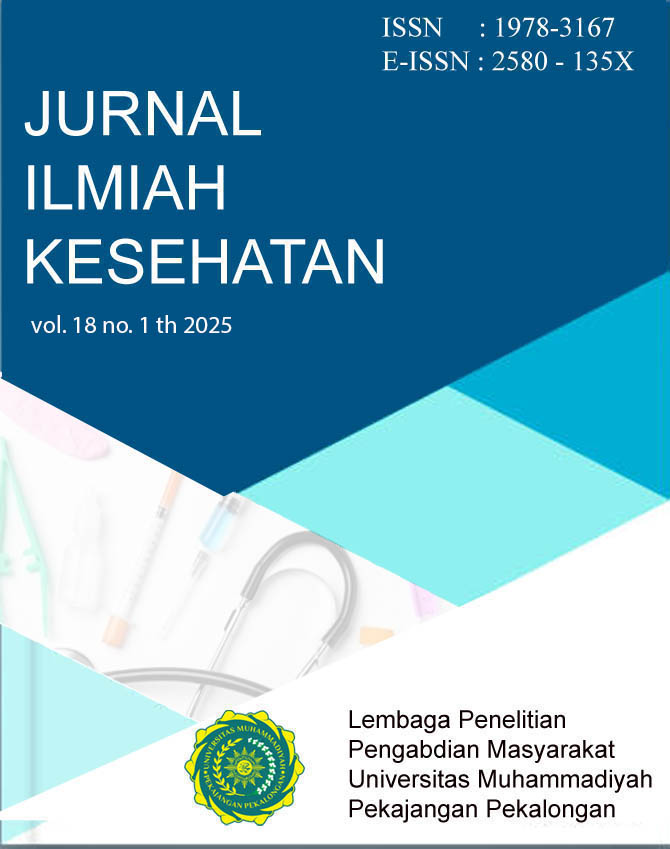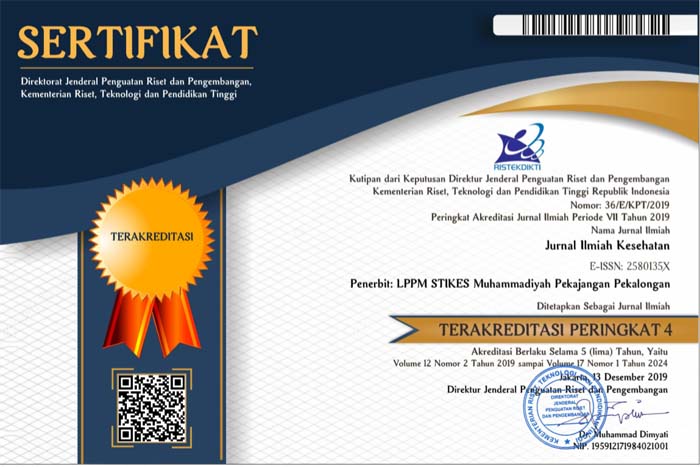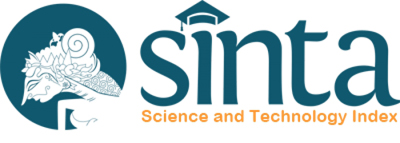Keikutsertaan Prolanis Berhubungan dengan Kepatuhan Konsumsi Obat Hipertensi
DOI:
https://doi.org/10.48144/jiks.v18i1.2021Keywords:
Hypertension, Drug Consumption Compliance, PROLANISAbstract
Hypertension is one of the chronic diseases with a high incidence rate that can cause serious complications such as stroke and heart failure. PROLANIS (Chronic Disease Management Program) managed by BPJS Kesehatan aims to increase drug consumption compliance in hypertension patients to control blood pressure and prevent complications. This research aims to analyze the relationship between participation in PROLANIS and compliance with the consumption of hypertension drugs at Taman Bacaan Health Center, Palembang. Research design is an observational analytical with a cross-sectional approach. The sample consisted of 94 hypertensive patients who followed PROLANIS, selected using the purposive sampling technique. Data was collected using the Medication Adherence Scale (MMAS-8) questionnaire and analyzed using the Chi-square test. As many as 63.8% of respondents regularly follow PROLANIS, and 57.4% have a high level of compliance in drug consumption. Statistical tests show a significant relationship between the participation of PROLANIS and compliance with the consumption of hypertension drugs (p-value = 0,005). There is a significant relationship between participation in PROLANIS and the level of drug consumption compliance in hypertensive patients. Regular participation in PROLANIS has the potential to increase treatment compliance and prevent hypertension complications.
References
W. H. O. (World H. Organization), “World Health Statistics 2017: monitoring health for the SDGs,” 2017, World Health Organization Geneva.
R. I. Kemenkes, “Hipertensi penyebab utama penyakit jantung, gagal ginjal, dan stroke,” sehatnegeriku. kemenkes. go. id, Jakarta, 2021.
L. F. Maulidati and C. Maharani, “Evaluasi program pengelolaan penyakit kronis (PROLANIS) pada masa pandemi COVID-19 di Puskesmas Temanggung,” J. Kesehat. Masy., vol. 10, no. 2, pp. 233–243, 2022.
K. Prihatin, B. R. Fatmawati, and M. Suprayitna, “Faktor-Faktor Yang Mempengaruhi Kepatuhan Berobat Penderita Hipertensi,” J. Ilm. STIKES Yars. Mataram, vol. 10, no. 2, pp. 7–16, 2020.
K. Kario, A. Okura, S. Hoshide, and M. Mogi, “The WHO Global report 2023 on hypertension warning the emerging hypertension burden in globe and its treatment strategy,” Hypertens. Res., vol. 47, no. 5, pp. 1099–1102, 2024.
N. M. E. Mayasari and R. Salsabilah, “RIWAYAT HIPERTENSI TERHADAP KEJADIAN ABNORMALITAS GAMBARAN ELEKTROKARDIOGRAM PADA PASIEN DIABETES MELITUS TIPE 2,” J. Kedokt. dan Kesehat. Publ. Ilm. Fak. Kedokt. Univ. Sriwij., vol. 6, no. 2, 2019.
N. M. E. Mayasari, P. zalika Kesuma, R. Asmalia, P. Wakila, and J. Angela, “Skrinning Penyakit Kardiovaskular melalui Pemeriksaan Elektrokardiografi pada Penderita Hipertensi dan Diabetes Melitus Tipe 2,” Indones. Berdaya, vol. 5, no. 3, pp. 811–818, 2024.
R. Yacob, R. Ilham, and F. Syamsuddin, “Hubungan Kepatuhan Minum Obat Dengan Penurunan Tekanan Darah Pada Pasien Hipertensi Program Prolanis Diwilayah Kerja Puskesmas Tapa,” Termom. J. Ilm. Ilmu Kesehat. Dan Kedokt., vol. 1, no. 2, pp. 58–67, 2023.
D. A. Setyawan and R. Fatoni, “Gambaran Kepatuhan Pasien Prolanis dengan Penyakit Hipertensi Rawat Jalan dalam Pemakaian Obat Periode Juli-Oktober 2022 di Puskesmas Wiradesa Kabupaten Pekalongan,” ULIL ALBAB J. Ilm. Multidisiplin, vol. 2, no. 5, pp. 1782–1789, 2023.
J. Hong et al., “Interventions that improve adherence to antihypertensive medications in coronary heart disease patients: a systematic review,” Postgrad. Med. J., vol. 98, no. 1157, pp. 219–227, 2022.
M. Wolde, T. Azale, G. Debalkie Demissie, and B. Addis, “Knowledge about hypertension and associated factors among patients with hypertension in public health facilities of Gondar city, Northwest Ethiopia: Ordinal logistic regression analysis,” PLoS One, vol. 17, no. 6, p. e0270030, 2022.
E.-W. Lee, H.-S. Kim, B.-N. Yoo, E.-J. Lee, and J. H. Park, “Effect of a primary care-based chronic Disease Management Program for Hypertension Patients in South Korea,” Iran. J. Public Health, vol. 51, no. 3, p. 624, 2022.
U. A. Nurhayati, A. Ariyanto, and F. Syafriakhwan, “Hubungan usia dan jenis kelamin terhadap kejadian hipertensi,” in Prosiding Seminar Nasional Penelitian dan Pengabdian Kepada Masyarakat LPPM Universitas’ Aisyiyah Yogyakarta, 2023, pp. 363–369.
P. Chhabra et al., “Gender-specific factors associated with hypertension among women of childbearing age: Findings from a nationwide survey in India,” Front. Cardiovasc. Med., vol. 9, p. 999567, 2022.
N. Susanti, S. N. Aghniya, S. S. Almira, and N. Anisa, “HUBUNGAN USIA, JENIS KELAMIN DENGAN PENYAKIT HIPERTENSI DI KLINIK UTAMA PARU SOEROSO,” PREPOTIF J. Kesehat. Masy., vol. 8, no. 2, pp. 3597–3604, 2024.
A. Harvey, A. C. Montezano, R. A. Lopes, F. Rios, and R. M. Touyz, “Vascular fibrosis in aging and hypertension: molecular mechanisms and clinical implications,” Can. J. Cardiol., vol. 32, no. 5, pp. 659–668, 2016.
S. Noviana and N. Nana Supriyatna, “Hubungan Kepatuhan Mengikuti Kegiatan Prolanis Dengan Tekanan Darah Pada Lansia Dengan Hipertensi Di Puskesmas Rajeg Kabupaten Tangerang,” 2019.
H. L. Memon, S. Z. Ahmed, S. Muhammad, and A. B. Babar, “Noncompliance to antihypertensive medication in patients with essential hypertension,” Pakistan J. Med. Heal. Sci., vol. 17, no. 05, p. 430, 2023.
E. Gustina, A. Harokan, and A. Wahyudi, “Analisis Kepatuhan Minum Obat Antihipertensi Pada Lansia dengan Hipertensi di Puskesmas Muara Enim Tahun 2024,” J. Ners, vol. 9, no. 1, pp. 606–616, 2025.
I. K. P. G. Sugihen, D. W. S. R. Wardani, R. Z. Oktarlina, and N. Carolia, “Hubungan hubungan keikutsertaan prolanis, kepatuhan minum obat dan status gizi terhadap kontrol tekanan darah pada pasien hipertensi di puskesmas kedaton kota bandar lampung,” Med. Prof. J. Lampung, vol. 12, no. 1, pp. 198–205, 2022.












